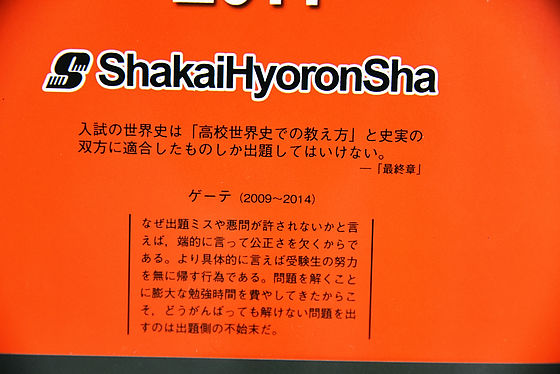'Absolutely unsolvable world history of exams' that collects difficult questions and mistakes in exam questions

Some of the university entrance exam questions are such as 'I can't narrow down the correct answer anyway?' 'I read every corner of the textbook and glossary, but I didn't get the answer ...' To do. A book that collects such difficult questions, bad questions, strange questions, and mistakes in questions is 'The World History of Examinations That Can Never Be Solved'.
Absolutely Unsolvable Examination World History | Comprehensive Book Publishing Shakai Hyoronsha
On the back cover of why this book was made, Goethe (2009) said, 'Because I have spent a lot of study time solving problems, it is a mischief on the questioning side to give problems that I can not solve no matter how hard I try.' ~ 2014) is quoted.

The binding of the

When you take off the obi, the girl on the cover turns into a school swimsuit. Furthermore, the secret is hidden on the back of the cover.

The contents are also red book style. Problems called 'bad questions' and 'strange questions' have been raised in

table of contents. From the new year, the problems are summarized by university.

For example, the problem at Sophia University in 2014 is to choose the correct description from five options. a, c, d can be excluded, and b or e is the correct answer. Since e, which 'Akamoto' answered correctly, has a time-series error, b is the answer if it is an elimination method. However, this is also classified as a 'bad question' because there is a point that it can be managed depending on the interpretation.

This is the problem of Keio University in 2014. Within the history of the test world, only two candidates, Egbert or Alfred the Great, can be selected as answers, so it is classified as a 'difficult question'.

It was a problem of Sophia University, and I chose

The reason why this was classified as a 'difficult problem' is that the photograph of Kemal used in the problem is different from the one that is often used, so it becomes an elimination method. As you can see in the commentary, b can

This is the picture of Kemal who 'teaches Latin letters using a blackboard' pointed out in the commentary.

Some are classified as 'close to question mistakes'. The reason is that the answer can be derived only by the question sentence and the lead sentence.

At Nagoya University, a question was asked about the promise that Han's high-ranking ancestor

Further 'bad questions' follow. The answer depends on whether the notation '2-1st century BC' written in the question text is received as 'from the 2nd century BC to the 1st century BC' or 'from the 2nd century BC to the 1st century BC'. Therefore, in this book, it is expressed as 'cutting class' together with the previous two problems.

This book contains not only problems but also columns.


In addition, it was a problem of the Faculty of Economics of Keio University that was described as the 'Best Award' in 2014, and the East and West camps during the Cold War looked at the color-coded map and chose which time in the chronological table. The answer can be narrowed down because Vietnam is divided into north and south, and Iraq and Cuba are color-coded to the west, but the Soviet Union has been dismantled (1991) and Yugoslavia has split (2003). If you look at the details, you will see a map that says, 'There is no time when that happened.'

If you are told that you can never solve it, you will want to try it, but it is also an interesting book to read. The price is 2200 yen (excluding tax).
Amazon.co.jp: Absolutely Unsolvable Examination World History (University Entrance Examination Question Series): Yoshitomo Inada: Book
http://www.amazon.co.jp/dp/4784511016

Related Posts:
in Review, Posted by logc_nt







